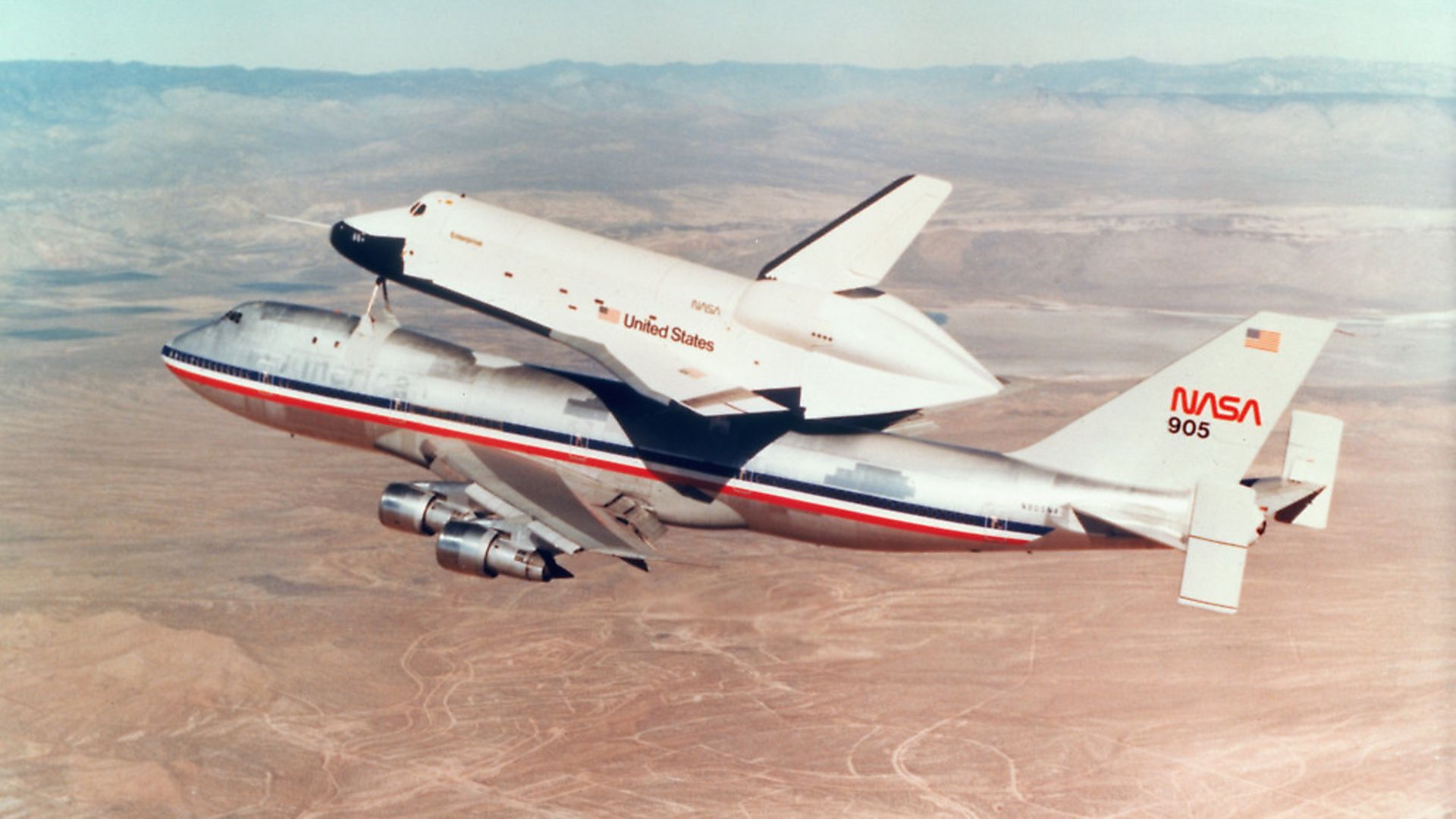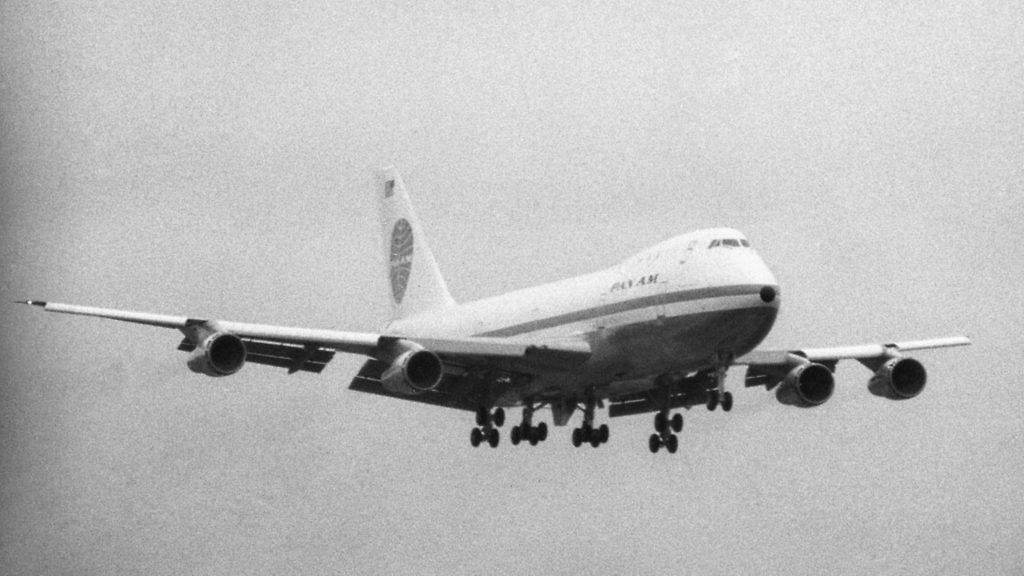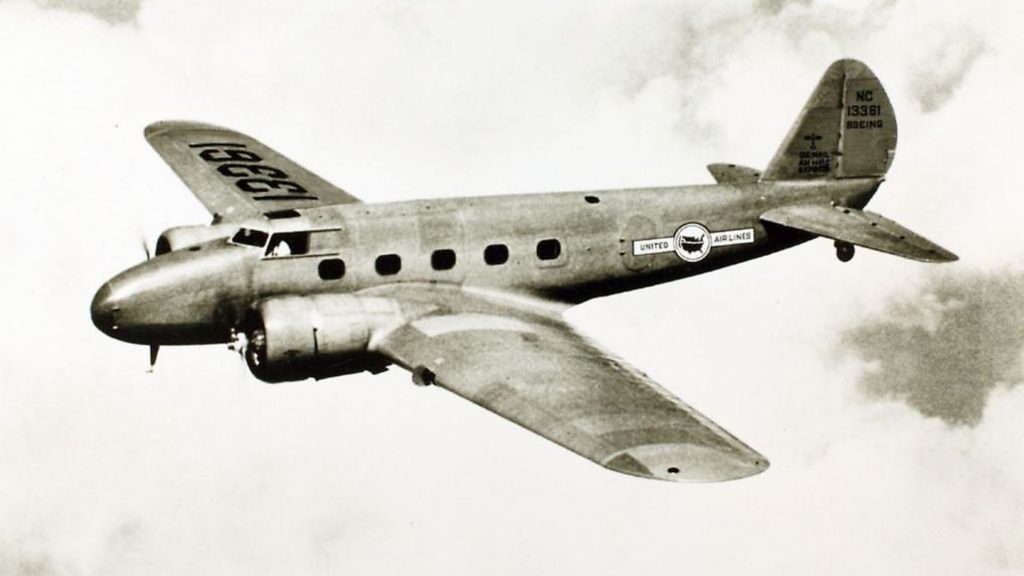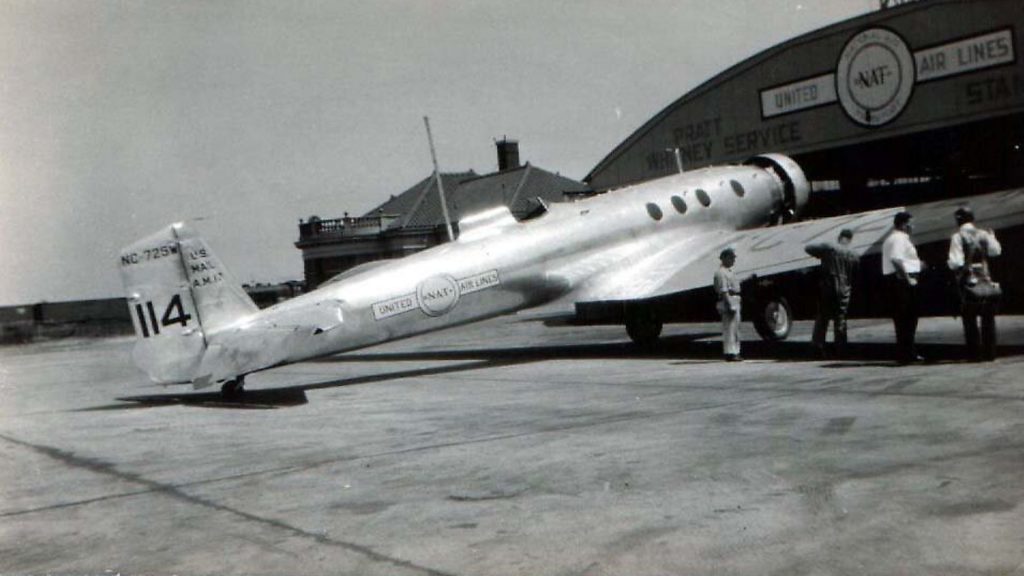
50 years ago, the first Boeing 747 took to the air and changed the world. IAN WALKER pays tribute to an astonishing feat of engineering, endeavour and imagination.
February 9 1969 was another cold, overcast day in what had been a bitter winter for America’s Pacific Northwest. The weather was one of the reasons why Boeing had not yet been able to test fly the new 747 ‘Jumbo Jet’ airliner it had assembled 30 miles north of Seattle, in a specially-constructed plant which remains the largest building ever built.
The project was now two months behind in what was already a very tight schedule – quite a cause for alarm for a company which had pretty much gambled its future on getting the 747 off the ground.
But the weather wasn’t the only problem. To get a plane of this size safely into the air required a new type of jet engine. Since 1965, the engineering company Pratt and Whitney had been working on developing one, and their JT9D seemed to meet the criteria. The engine’s vast 8ft fan not only sucked air into the core of the engine, it also forced air around it, significantly improving its propulsion and providing more than enough to get the new aircraft airborne. The ‘bypass’ air flow also had the added benefit of reducing the noise from the core, which was vital if the 747 was going to become the world’s main long-haul aircraft, flying in and out of the globe’s major cities.
Yet despite these evident qualities, there was a drawback to the new engine: in testing, 60 had failed, with some of them exploding spectacularly in a shower of sparks.

Despite this ominous track record, though, the tests had left engineers with a pretty clear idea of the parameters in which these new engines could operate safely. And with Boeing haemorrhaging $20 million a day in development costs, a test flight was scheduled for February 9.
Still, though, the factors beyond human control – a low, grey sky, with snow on the ground – looked like they might create a further delay. Then, just before noon, there was a break in the clouds and a bright, blue window appeared beyond it. The final decision to proceed was made.
Boeing’s staff were acting as casually as possible – the three-man crew, led by test pilot Jack Waddell, even made sure they were dressed in their own clothes. The company, which had so much resting on the next few moments, wanted the flight to appear to outsiders as perfectly routine. Of course, it was anything but.
Out on the runway, this behemoth – two and half times bigger than any existing airliner – looked sluggish and unnatural as it gained speed. And then, suddenly, there it was, airborne, in its natural environment. When the crew returned, one hour and 15 minutes later (the flight was curtailed by a minor problem with a wing flap) they reported the aircraft had handled beautifully and had taken turbulence in its stride. Aviation would never be the same again.

The 747 is one of the great inventions of the last century, the American century. It has become one of the signifiers, like the Cadillac, the Coke can or Mickey Mouse, of the leisure society, of American affluence and confidence. The aircraft was designed to shrink the world by making long-haul commercial air travel possible. And it achieved exactly that.
For a while, it made flying almost as glamorous as it had been during the pre-war golden age of aviation, or as cool as it had been when Sinatra asked us to come fly with him as he headed off for exotic booze in a bar in far Bombay. The 747 had swagger. It was sexy, stylish and egalitarian.
But the 747 was also a relation of those other signifiers of the American century, the B-17 Flying Fortress, the B-29 Superfortress and the B-52 Stratofortress (all built by Boeing – although the B stands for ‘bomber’). That American century was one of war, bravery, sacrifice and the defeat of fascism, but also ruined German cities, created mushroom clouds over Hiroshima and Nagasaki, and napalmed children in Vietnam. The history of Boeing is about innovation and destruction, leisure and horror, and these contradictory strands have run through its DNA almost since its beginning.
The company’s origins can be traced back to a barn in Washington state in 1916. William Boeing’s family had made a fortune in timber in the Pacific Northwest, and William continued in the family business. But by 1916, he was obsessed by flying and quickly realised that he could build a better timber-framed aircraft than the ones that were available. So, teaming up with his friend, the US Navy engineer George Westervelt, that’s what he did.

This first Boeing plane, the B&W sea biplane, performed well and Boeing and Westervelt turned their barn into a factory and started producing the Boeing Number 1, the B&W seaplane.
Then, in 1917, America entered the First World War and the US military ordered 50 planes. The Boeing company, through a combination of talent, timing and war, was up and running.
From that point on, Boeing in its various corporate forms (it has gone through all sorts of mergers and acquisitions) followed a strategy of developing commercial aircraft that could have military applications, or producing military aircraft with technology that could be then used in the commercial sector. This meant the company could play a leading role in the development of commercial air transport whilst also trying to secure lucrative government contracts.
Lots of aviation companies – and not just in the USA – went through this same process of moving between commercial and military markets, but Boeing (from now on ‘Boeing’ refers to the company and not the man – William Boeing’s involvement in the company was largely over by 1937) became particularly good at it. The process of adaption between civil and military really took a step forward with the construction of an aircraft called the Monomail in 1930.
It was the first recognisable single-wing passenger airliner, yet for all its revolutionary potential only two were built. With a few adaptations, however, it became the Boeing 247 – the great-great-grandfather of the 747. Again, though, there was no immediate sign that the company was on a flight path to anything special. In the 1920s and 1930s, Boeing did not do much more than get by and the 247 did not thrive as a passenger plane, remaining firmly in the shadow of the more popular Douglas DC-3.
It was the Second World War that really gave Boeing wings. In the years leading up to it, the company, like many aircraft manufacturers working in what was a paranoid and militaristic world, was developing a long-range bomber. Its attempt, the XB-15, was rejected by the military so the firm went away and combined aspects of it with the 247 airliner. The result was the B-17 Flying Fortress, one of the most important aircraft of the Second World War and one of the most famous of the last century.
Not long after the B-17 came the B-29 Superfortress with its pressurised body, which meant it could fly higher and further. It was the B-29 that dropped the atomic bombs on Hiroshima and Nagasaki. Following the B-29, and with the development of jet technology, came the giant – and terrifying – Cold War sweep wing bomber, the B-52.
In the post-war period, alongside this development of weapons of mass destruction, Boeing returned to civil aviation. Much had been learnt by its engineers in the building of bombers, especially around pressurised cabins and sweep wing jet technology, so the company, inspired by the British Comet aeroplane (which never lived up to its potential) developed its own jet-propelled airliners.
First, in 1958, came the 707, then the 727 and then the 737. Throughout the late 1950s and the 1960s, barely 30 years after the Monomail, Boeing, with its short and medium range air transport, transformed the way millions of people moved around the planet.
Thanks to this new jet-set culture of cheap, rapid travel, and to the threat of nuclear annihilation, Boeing was, by the mid-1960s, a market leader. The question now was what to do next? There were three options. The first was to turn again to the military and bid to build the new massive bulk transport jet which it wanted, especially now the war in Vietnam was escalating. The second was to invest in developing a supersonic plane. The third was to create an aircraft that would corner the long haul market.
In the end, Lockheed won the bid to build the transport aircraft (and became bogged down for years trying to get the C5 Galaxy to work properly), so Boeing turned to the other choices. The priority was the supersonic jet; getting people to move faster was the ambition. But then the head of Pan Am, Juan Trippe – a pathologically driven and fiercely optimistic character – made a stunning request. He wanted a plane that could carry more than 500 passengers more than 6,000 miles. And he wanted 25 of these within 28 months.
Somewhat recklessly, Boeing took him up on it and set to work on what was only intended to be a secondary project behind the supersonic jet. But there was nothing second tier about the development process. It was, in every sense, a massive undertaking.
To assemble the plane, Boeing built the Everett factory, still the world’s largest building by volume. It is so vast that clouds form inside, under the ceiling. This was not where all the construction was to take place though. The project was too vast for that. Once the designers had settled on a plan, they subcontracted out the building of bits of the aircraft to a who’s who of American industrial might. The fuselage was built by Northrop, parts of the wing by Goodyear, the undercarriages by the Cleveland Tool Company and the rest by dozens of others – including the engines by Pratt and Whitney. Many of the parts were to brought by special railway into the factory, where the whole jigsaw was to be assembled.
But what was the design? Trippe had wanted a double-decker plane, but Joe Sutter, who was head of the project, rejected the idea. It looked ugly and it wasn’t safe. So instead of going upwards, the designers went sideways. The 747 would be the first wide-body passenger aircraft. This had the added bonus of allowing the plane to be adapted for military transport if the need arose (and Boeing – with an eye ever on spreading itself across civil and military markets – would have been more than aware of the difficulties Lockheed were having with the Galaxy).
But if the aircraft was to have a transport application, then the best way of loading it would be through the nose. What, then, should you do with the cockpit? The answer was to shove it on the top of the plane and then add a small, extra passenger area behind it, producing the 747’s distinctive hump. It also meant Trippe got his second deck after all.
The cost of this ‘secondary’ project was crippling, and as the debt started nudging towards $2bn the executives realised the company could collapse. At one point they threatened to cut the workforce by a third – which would have been a disaster – but everyone just about held their nerve and on September 30, 1968, the first 747 rolled out of the Everett factory to be seen by an audience made up of the world’s press and representatives of the 26 companies that had ordered the plane. It had all been done in such a rush that the paint on the plane was still wet. More importantly, it didn’t have any engines.
The specific problem causing delay to these was that when the jets were put under extreme stress – as they would be when taking-off with a heavily-laden aircraft – the casing bowed and was shredded by the fan. But identifying the problem was easier than solving it, and the issue was still not resolved even after the February test flight.
Boeing was frustrated and felt that Pratt and Whitney were not acting urgently enough to make their engines safe. So they came up with a plan, which in hindsight seems utterly absurd. In a later test flight, the pilot Jack Waddell took one of Pratt and Whitney’s executives up in the plane and then deliberately put one of the engines under the kind of stress that caused the fan and the casing to fail.
The 747 was now flying on three engines. Waddell then acted as if to do it again to another engine. This was the moment that Pratt and Whitney resolved to get the problem sorted. Less than a year later, in January 1970, the 747 entered service with a flight between New York and London.
Boeing got everything right with the 747. It became the backbone of the fleets of almost all of the world’s major airlines and it changed all sorts of fundamental things about air travel. For example, airports had to get bigger just to cope. And it was the 747 that was the premier symbol of air travel in the 1970s and 1980s, and not supersonic travel.
Boeing’s plan for a supersonic jet had been dropped in the early 1970s. The project had been partly funded by the US government and in March 1971, Senate, because of budgetary and environment concerns, cut funding. It was the Anglo-French Concorde that became the poster boy for supersonic travel – but that’s all it ever was. Concorde was sleek, stylish and fast but it did not revolutionise air travel in any fundamental way – not like the 747. Even BA’s advertising campaigns in the 1980s tended to use the jumbo jet as its flagship aircraft.
The triumph of the 747 was first and foremost a triumph of engineering and endeavour in a stupidly short period. Around 50,000 construction workers, mechanics, engineers and others had taken it from an idea to the air in just 16 months. However, for most passengers who used the plane in the 1970s and beyond, it was the last piece of the jigsaw – the interior design – that was most memorable.
This was the responsibility of Walter Dorwin Teague Associates. Walter Teague had been one of the great American industrial designers of the last century. In 1946, he had designed the interior of the Boeing Stratocruiser, an attempt by Boeing to create a passenger plane based on the Superfortress. The design was spacious, stylish and sleek and created a relationship between Teague and Boeing that meant, even after his death in 1960, his agency continued its close partnership with the aviation firm.
The designers relished the space they had with the 747. The interior was light and airy and was packed with futuristic space-age chic. And then there were the bars, which were the height of 1970s kitsch. They looked like a Vegas bamboo lounge or something from 2001: A Space Odyssey – and some of it is hilarious to look at now. But it was cool. Everything about the 747 was cool.
Boeing continues to be a military contractor. It is still part of that hoary old villain, the American military-industrial complex, which is often wheeled out to provide simplistic explanations to complex historical processes. But the 747 represents that different side of Boeing’s contribution to the American century. The Jumbo Jet shrunk the world and did so at a time when the world was just starting to emerge with confidence from the conflict and devastation that had characterised the 20th century up to that point.
No one would argue that the last 50 years have been perfect but they were certainly better than the 50 years that went before that, and all the things that have made these last five decades relatively decent, at least here in the western world – no global wars, cheap mass travel, a positive view of globalisation, technological advance – are all somehow bound up with the Boeing 747. It is just these positive characteristics, of course, which have made the aircraft such a potent target, over the years, for terrorists. More than anything the Jumbo Jet is a signifier of something optimistic, and therefore something to be attacked. It was, and still is, air travel – and America – at its very best.
BOEING BEYOND: WHERE NEXT FOR THE 747?
JANET BEDNAREK takes up the story of the 747, from its test flight, to what the future might hold for it
Boeing went on to build more than 1,500 747s and about 500 still fly today. It debuted at the end of the so-called golden age of flight, a time when air travel still was seen as glamorous and most airlines catered to an elite clientele.
As such, early operators used the upper deck as a passenger lounge for first-class passengers, rather than filling the plane to its full capacity.
In the late 1970s, in an effort to entice more passengers, American Airlines went one step further, turning the lounge into a piano bar complete with a Wurlitzer organ and entertainer who led singalongs with the passengers.
Deregulation of the US airline industry in 1978, however, soon made such glamorous amenities obsolete as airlines focused on cutting costs rather than offering high services. And over time, smaller and more efficient long-range twin-engine aircraft like the 777 and 787 diminished the need for a hulking jumbo jet.
Despite this, the 747 won a coveted place in American popular culture. It ‘starred’ in two disaster movies – Airport 1975 and Airport ’77, not to mention several films that involved hijackings.
The 747 also gained further fame from certain specialty missions. NASA, for example, used a modified 747 to transport the space shuttle between landing and launch sites. And, of course, since 1990, a pair of 747 have been operating as Air Force One, the plane that ferries around the US president. In 2024, the 747-8 – possibly painted red, white and blue at Donald Trump’s request – will take over the job, with a longer range, slightly higher speed and a higher maximum take-off weight.
But Boeing has no plans to assemble another for the airlines. US airlines stopped flying 747s in 2017, and what looks to be the last passenger 747-8 went to Korean Airlines the same year.
The aircraft, however, may still have a long life as a carrier of freight – UPS, for example, recently ordered 14 of them – as well as the American president, which means these icons of aviation will still fly well into the 21st century.
Janet Bednarek is a professor of History at the University of Dayton; this article also appears at theconversation.com.









